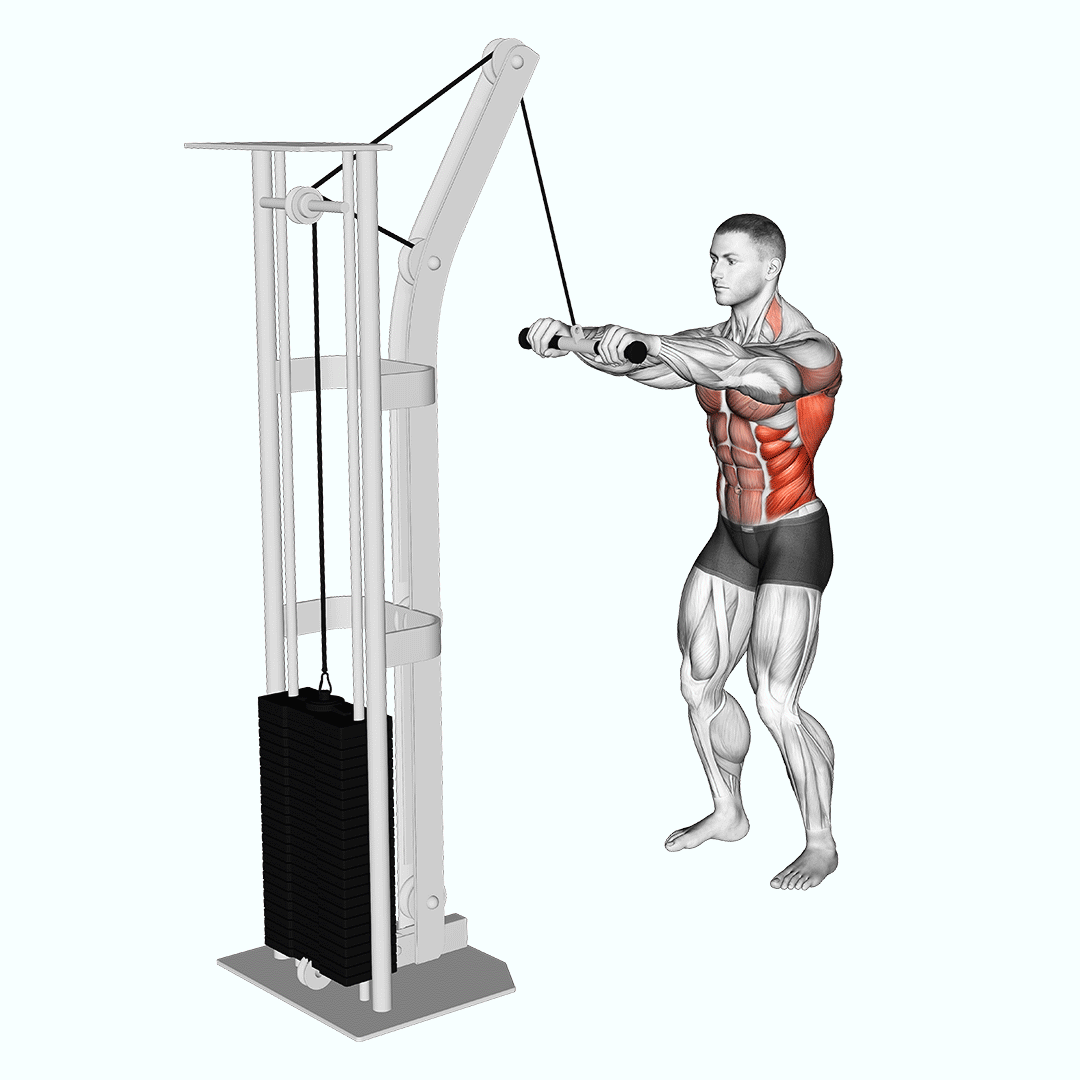The Cable Thibaudeau Kayak Row is an effective exercise for strengthening your lats and enhancing upper body strength while improving posture. This unique rowing motion engages not only your back muscles but also your core and shoulders, making it a multi-muscle workout ideal for anyone aiming to achieve a toned physique or increase overall lifting power.
Focusing primarily on your latissimus dorsi, this exercise also targets the rhomboids and trapezius for a balanced upper body workout. By incorporating the rotational movement, it simulates the action of kayaking, providing functional strength benefits. Perform the Kayak Row 2-3 times a week, allowing for recovery between sessions. Integrate this exercise into a comprehensive program by pairing it with movements that target different muscle groups, promoting overall strength and endurance.
Safety is crucial; maintain a neutral spine and engage your core throughout the motion. Avoid using momentum— each pull should be controlled. Use a cable machine set to a high pulley with a straight bar attachment for optimal performance. If you’re new or have limited mobility, start with lighter weights or no added resistance until you’re comfortable with your form. Embrace the Cable Thibaudeau Kayak Row as a step toward your fitness goals; every repetition brings you closer to strength and empowerment.
How to Do a Cable Thibaudeau Kayak Row

Setup:
- Attach a straight bar to a high pulley on the cable machine.
- Stand facing the machine with your feet shoulder-width apart.
- Grasp the bar with both hands using an overhand grip, arms fully extended above you.
Execution:
- Engage your core muscles and keep a slight bend in your knees for stability.
- Pull the bar down toward one side of your body, bending your elbow and keeping the other arm extended.
- As you pull, rotate your torso slightly, mimicking a kayaking motion.
- Squeeze your lat muscle on the pulling side at the bottom of the movement.
- Slowly extend your arm back to the starting position while maintaining control.
- Repeat the movement on the opposite side.
- Continue alternating sides for the desired number of repetitions.
Breathing:
Level Up Your Fitness: Join our 💪 strong community in Fitness Volt Newsletter. Get daily inspiration, expert-backed workouts, nutrition tips, the latest in strength sports, and the support you need to reach your goals. Subscribe for free!
- Inhale as you prepare and extend your arms.
- Exhale as you pull the bar down and engage your lats.
Tips:
- Keep your movements smooth and controlled.
- Avoid shrugging your shoulders; keep them down and relaxed.
- Focus on the mind-muscle connection with your lats during each repetition.
Common Mistakes
Understanding and avoiding common mistakes will help you perform the Cable Thibaudeau Kayak Row effectively:
Level Up Your Fitness: Join our 💪 strong community in Fitness Volt Newsletter. Get daily inspiration, expert-backed workouts, nutrition tips, the latest in strength sports, and the support you need to reach your goals. Subscribe for free!
- Neglecting Core Engagement: Failing to engage the core can lead to poor posture and back strain. Keep your abdominal muscles tight throughout the exercise to stabilize your spine.
- Using Momentum: Swinging or jerking the weight reduces effectiveness and increases injury risk. Focus on slow, controlled movements to maximize muscle engagement.
- Excessive Weight Selection: Choosing too much weight may compromise your form. Start with a manageable load that allows you to maintain proper technique throughout the set.
- Improper Grip: Holding the bar incorrectly can decrease efficiency. Ensure your hands are evenly spaced and maintain a firm overhand grip.
- Limited Range of Motion: Not fully extending the arms or not pulling down completely limits muscle activation. Perform the exercise through a full range of motion for optimal results.
- Shoulder Shrugging: Lifting your shoulders towards your ears can strain your neck. Keep your shoulders down and relaxed during the movement.
Benefits of the Thibaudeau Kayak Row
Incorporating the Cable Thibaudeau Kayak Row into your workout routine offers several advantages:
- Enhances Lat Development: Primarily targets the latissimus dorsi, promoting muscle growth and increased back width.
- Improves Upper Body Strength: Engages multiple muscle groups including the rhomboids, trapezius, and rear deltoids, contributing to overall upper body power.
- Increases Core Stability: The rotational aspect strengthens the obliques and transverse abdominis, enhancing balance and stability.
- Boosts Functional Movement Patterns: Mimics real-life rowing motions, improving coordination and functional fitness applicable to daily activities and sports.
- Adjustable Resistance Levels: The cable machine allows for easy adjustment of resistance, making it suitable for beginners to advanced athletes.
- Enhances Mind-Muscle Connection: Requires focus and control, improving neural pathways to the targeted muscles for better activation.
Variations
To add variety and challenge to your workouts, consider these variations:
1. Seated Cable Kayak Row
- Setup: Sit on a bench or the floor facing the cable machine.
- Execution: Perform the same kayaking motion while seated, which emphasizes isolation of the upper body and reduces lower body involvement.
2. Single-Arm Cable Kayak Row
- Setup: Use a single handle attachment.
- Execution: Perform the exercise one arm at a time, focusing on unilateral strength and addressing any muscle imbalances.
3. Resistance Band Kayak Row
- Setup: Attach a resistance band to a sturdy anchor point above you.
- Execution: Mimic the kayak row movement using the band, which is convenient for home workouts or when equipment is limited.
Exercise Variations
Alternatives to the Cable Thibaudeau Kayak Row
If you’re looking to target your lats with different exercises, try these alternatives:
1. Lat Pulldown
- Description: A classic exercise targeting the lats using a cable machine with a wide bar.
- Benefits: Builds back width and strength, suitable for various fitness levels.
2. Dumbbell Row
- Description: Uses dumbbells to perform rowing motions, either bent over or supported on a bench.
- Benefits: Enhances back thickness and can be performed unilaterally to correct imbalances.
3. Pull-Ups or Chin-Ups
- Description: Bodyweight exercises that require pulling your body up to a bar.
- Benefits: Excellent for building upper body strength and engaging multiple muscle groups including the lats, biceps, and shoulders.
Alternative Exercises
Safety Precautions for the Cable Thibaudeau Kayak Row
Prioritize your safety by following these guidelines:
- Proper Setup: Ensure the cable machine is in good condition. Check that the attachments are secure and the weight stack pins are properly inserted.
- Weight Selection: Start with a lighter weight to master the form before progressing to heavier loads.
- Posture: Maintain a neutral spine and avoid excessive leaning or twisting to prevent back strain.
- Core Engagement: Activate your core muscles to stabilize your torso throughout the exercise.
- Controlled Movements: Perform the exercise slowly and deliberately, avoiding any jerky motions.
- Breathing: Exhale during the pulling phase and inhale when returning to the starting position to maintain proper oxygen flow.
- Footwear and Attire: Wear non-slip shoes and comfortable clothing that allows for a full range of motion.
- Listen to Your Body: If you experience pain or discomfort beyond typical muscle fatigue, stop the exercise and consult a fitness professional.
Contraindications:
- Individuals with shoulder, elbow, or lower back injuries should consult a healthcare provider before performing this exercise.
- If you have limited shoulder mobility, consider performing modified versions or alternative exercises.
Final Thoughts
The Cable Thibaudeau Kayak Row is a dynamic exercise that effectively targets the lats while engaging the entire upper body and core. By incorporating this movement into your training routine, you can enhance muscle development, improve functional strength, and achieve better posture. Remember to focus on proper form, start with appropriate weights, and progressively challenge yourself as your strength improves. With consistency and dedication, you’ll be well on your way to building a stronger, more defined back.
Interested in measuring your progress? Check out our strength standards for Pull Ups, Dumbbell Row, Chin Ups, and more.








